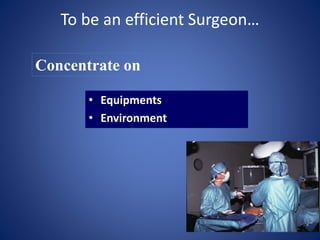Laparoscopy & its Ergonomics by Dr.Mohammad Zarin
- 2. Ergonomics & Physiology In Laparoscopic Surgery Dr.Mohammad Zarin MBBS, FCPS, MRCS, FMAS Associate Professor, SEW Khyber Teaching Hospital
- 4. Outline of Presentation ŌĆó Ergonomics ŌĆó Physiology ŌĆó Instruments
- 6. 2 D Image No depth Perception No tactile feedback Counter-intuitive Limited movements Magnification
- 7. Open Surgeon Vs Lap Surgeon How do they differ?! Open Surgeon ŌĆó Fast ŌĆó Hand is as good as eyes ŌĆó Dissection precedes ŌĆó Ergonomics: Optional Laparoscopic Surgeon ŌĆó Slow and steady ŌĆó Stop when you donŌĆÖt see ŌĆó Haemostasis precedes ŌĆó Ergonomics: Vital
- 8. To be an efficient SurgeonŌĆ” ŌĆó Equipments ŌĆó Environment Concentrate on
- 9. PATIENT POSITION Produce gravitational displacement of viscera away from surgical site. Trendelenberg Rev Trendelenberg 15-20˚ head down 20-30˚ head up Endobronchial intubation Predisposition to DVT
- 11. Ergonomics ŌĆó Straight Line principle ŌĆó Triangulation ŌĆó Manipulation angle ŌĆó Elevation angle ŌĆó Low lying table ŌĆó Gaze down view
- 13. Visual Axis and Motor Axis
- 15. Base Ball Diamond Concept & TriangulationMonitor S C R L P
- 16. Manipulation angle Azimuth Angle Manipulation Angle 30-45 degree 60-90 degree
- 17. Elevation angle
- 18. Ideal angles! 1. Manipulatation angle: 60 degree 2. Azimuth angle: Equal/30 degree each 3. Elevation angle: 60 degree
- 19. Ergonomics of Hand Instruments ŌĆó Tip ŌĆō Range of movements ŌĆó Conventional Vs Robotic instrument: 4: 7
- 20. Ergonomics of Hand Instruments ŌĆó Tip ŌĆō Range of movements ŌĆó Conventional Vs Robotic instrument ŌĆó Length of the shaft
- 21. Fulcrum Effect of Hand Instruments 1: 1
- 23. Ergonomics of Port Placement
- 24. Ergonomics of Hand Instruments ŌĆó Tip ŌĆō Range of movements ŌĆó Conventional Vs Robotic instrument ŌĆō Force transmission ŌĆó Length of the shaft ŌĆó Handle design
- 26. SurgeonŌĆÖs Stance Ideal relaxed stature Tiring
- 27. Ideal Relaxed Position -straight head, in the axis of the trunk, without rotation or extension of the cervical spine; - shoulders in a relaxed and neutral position; - arms alongside the body - elbows bent to 70 to 90 degrees - forearms in an horizontal or slightly descending axis- -hands pronated (physiological resting position); - hands and fingers lightly grip the handles/handpiece ŌĆóWaist line table ŌĆóGaze down view of monitor ŌĆóStraight line principle ŌĆóTriangulation
- 28. PHYSIOLOGICAL EFFECTS OF LAPAROSCOPY Can be: ’āś Mechanical ’āś Metabolic On ŌĆó Cardiovascular ŌĆó Pulmonary ŌĆó Gastrointestinal ŌĆó Renal ŌĆó Peripheral vascular
- 29. Cardiovascular Effects: Ōåæ IAP Ōåō CO Ōåō VR Ōåō SV Ōåæ Afterload Ōåæ MAP HRx = Ōåæ Vasopressin & Catecholamines Ōåæ CO2 Ōåæ CVP Ōåæ PCWP Ōåæ SVR Ōåō VR Ōåō LVEDV
- 30. Cardiovascular Effects: ŌĆó Cardiac Output ŌĆō Variation between studies ŌĆō < 30% decrease when observed ŌĆō On insufflation; Ōł× Ōåæ in I.A.P; transient ŌĆó generally noted in: ŌĆō ASA Class III/IV ŌĆō hypovolemic patients ŌĆō PP > 15 mm Hg ŌĆō reverse Trendellenberg position
- 31. Respiratory Effects: Ōåæ IAP Ōåæ cephalad shift diaphragm paradoxic diaphragm motion Ōåæ ITP Ōåō FRC Ōåæ RR Ōåæ CO2 Ōåæ Ve & work of breathing Ōåōchest wall compliance Hypercapnia Ōåæ PAWP + Alveolar Collapse Ōåō TV
- 32. Respiratory Complications: ŌĆó Pneumothorax / Pneumomediastinum / Pneumopericardium ŌĆō 2┬░ to diffusion of gas from pneumoperitoneum ŌĆó Accidental diaphragm injury / pre-existing diaphragmatic defect ŌĆō 2┬░ to rupture of blebs with Ōåæ PAWP ŌĆó Gas Embolism ŌĆō 2┬░ to vascular injury ŌĆó trocar / needle insertion on insufflation / intra-op vessel injury
- 33. Gastrointestinal effects: Ōåæ I.A.P. Ōåō Mesenteric & celiac flow Ōåō hepatic artery flow Ōåō hepatic perfusion Ōåō perfusion intestines & stomach Ōåō Portal flow Ōåæ LFTs Ōåō intestinal & gastric pH
- 34. Renal Effects: Ōåæ I.A.P. Ōåō GFRŌåōERPF Ōåō U/O RAAS Ōåæ CO2
- 35. Renal Effects: ŌĆó U/O return to baseline within hours ŌĆó No long-term change in GFR ŌĆó No change in Cr, BUN
- 36. Peripheral Vascular Effects: Ōåæ I.A.P. Reverse Trendellenberg Venous stasis Ōåō VR Ōåæ Risk DVT?
- 37. Peripheral Vascular Effects: ŌĆó Incidence of DVT, PE generally lower post laparoscopic procedures ŌĆō Secondary to improved prophylaxis? ŌĆō Risk increased with longer procedures and reverse Trendellenberg
- 38. Laparoscopic Instruments ŌĆó Hand instruments
Editor's Notes
- #11: Trendelenburg position (head down) usually for gynaecological procedures or Reverse trendelenburg (head up) for upper GI surgery. Trendelenburg: Greater respiratory effects including further reduction in FRC, more V/Q mismatch and greater risk of atelactasis. Initial increase in VR may not be tolerated in patients with compromised myocardial compliance. Reverse Trendelenburg: More marked effects on CV system due to decreased VR and CO therefore low BP. 3 most common patient positions: supine ŌĆō for majority of procedures including cholecystectomy, appendectomy, gastric small bowel, colonic and vascular proceures. Modified lithotomy position used for procedures in pelvis. Allen stirrups used to hold leg in position. Lateral decubitus position most often used for splenectomy, adrenalectomy and thoracoscopic procedures.












































